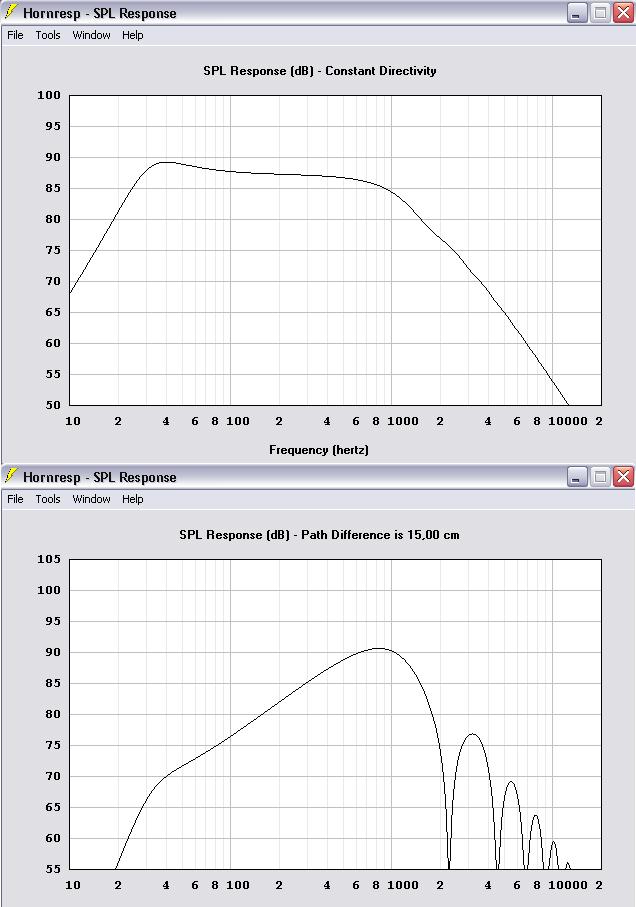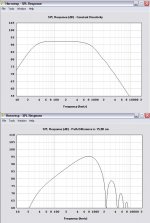not 79dB 1wmtr is faulty it is 78dB 1wmtr.here two eminence alpha in series ad 3dB for serie config and then with four drivers the cut of is 35hz and spl will be 79dB 1wmtr.
Series is not a great way to go for passive OB. You'll need a massive inductor for your low pass filter. And you'll need higher voltage from your amp to reach needed SPL. Running them in parallel works much better in practice.
That isn't the idea that I explain.
The series resistance helps to chance the behaivour of the response like you want to see. Like I show here.

And see the same driver with out series And when the impedance of 8Ohm is to high use another pair parallel.
Attachments
Yes, the series resistance changes the Q. That's going to change the response. So will a 6 ohm resistor.
But from a practical standpoint series doesn't work well. 2 drivers in parallel do. But don't take my word for it, try it for yourself! And if you do like it better, you can say "I told you so!!"
But from a practical standpoint series doesn't work well. 2 drivers in parallel do. But don't take my word for it, try it for yourself! And if you do like it better, you can say "I told you so!!"
I think you need to define your goals for the infinite baffle driver. IMO there are a few things that are important in parameters and then the things that parameters alone do not show. There are two theories for the Q of an open baffle driver. Some want a more damped Qts around .5 for "tighter" sound. Others want a Qts of 1.0 or higher to get that little boost before the driver begins to roll off. I personally like to be right in the middle there A Qts between .7 and 1.0 really gives you the best of both worlds with the lowest F3 point (before baffle rolloff) and still good damping.
You'll want a driver that is flat to below your lowest useable point. So if you determine 30hz, you don't want rolloff in the driver until below 30hz. Otherwise you are compensating for both the baffle rolloff and the natural driver rolloff.
You want high Xmax. In an OB you are compensating for massive amounts of baffle rolloff. A baffle of 18-20" wide will have around 13-14dB of loss by 30Hz. To compensate for this you need to move huge amounts of air. You either need many drivers, or drivers that can move farther.
You also want linearity in the parameters. This is the one thing that is so overlooked. The Alpha15 with Qts of around 1.3 looks fine on paper. However it has only 3mm Xmax. By 3mm suspension gets stiffer and Bl has dropped 30%. The Qts at this point is over 3.0! Model that once vs the model based on the T/S parameters and it no longer looks good.
Also when moving a driver to Xmax, you have issues with inductance changing. The typical S shaped Le curve means that the upper response of the driver is changing from the inward to outward stroke. If you made a passive crossover, it's no longer valid once the impedance curve changes. This is why many speakers sound good at low volumes but start to sound horrible in the crossover region as they are played louder.
Then as you apply power the VC becomes an electromagnet. The more power you apply, the stronger the electromagnet. As you move this new magnet through the permanent magnetic field, the flux in the permanent field is pushed around. This has huge effects on positioning the coil where it is supposed to be.
Nick McKinney originally designed the Dipole15 to combat all these issues. It has a Qts of .94 with an Fs of 21.7Hz. It will model with an F3 point in the mid 20's so it is flat well below the 30Hz low end goal that most people go for. That means you're not compensating for the driver rolloff at all, only the baffle rolloff. It has an underhung motor with 12mm one way Xmax. This means it can move a lot of air and remain linear when doing so. It can move as much air as 4 Alpha15's and only take up the space of one driver on a baffle. The Bl barely changes out to the 12mm point, keeping the Qts also consistent. The copper sleeve on the pole reduces most all flux modulation and the inductance doesn't change at all with excursion. That means it sounds the same at 12mm as it does at rest.
All of these things factor in to why the Dipole15's are really unmatched for open baffle applications.
Acoustic Elegance • View topic - Dipole10, Dipole12, Dipole15 parameters
John
You'll want a driver that is flat to below your lowest useable point. So if you determine 30hz, you don't want rolloff in the driver until below 30hz. Otherwise you are compensating for both the baffle rolloff and the natural driver rolloff.
You want high Xmax. In an OB you are compensating for massive amounts of baffle rolloff. A baffle of 18-20" wide will have around 13-14dB of loss by 30Hz. To compensate for this you need to move huge amounts of air. You either need many drivers, or drivers that can move farther.
You also want linearity in the parameters. This is the one thing that is so overlooked. The Alpha15 with Qts of around 1.3 looks fine on paper. However it has only 3mm Xmax. By 3mm suspension gets stiffer and Bl has dropped 30%. The Qts at this point is over 3.0! Model that once vs the model based on the T/S parameters and it no longer looks good.
Also when moving a driver to Xmax, you have issues with inductance changing. The typical S shaped Le curve means that the upper response of the driver is changing from the inward to outward stroke. If you made a passive crossover, it's no longer valid once the impedance curve changes. This is why many speakers sound good at low volumes but start to sound horrible in the crossover region as they are played louder.
Then as you apply power the VC becomes an electromagnet. The more power you apply, the stronger the electromagnet. As you move this new magnet through the permanent magnetic field, the flux in the permanent field is pushed around. This has huge effects on positioning the coil where it is supposed to be.
Nick McKinney originally designed the Dipole15 to combat all these issues. It has a Qts of .94 with an Fs of 21.7Hz. It will model with an F3 point in the mid 20's so it is flat well below the 30Hz low end goal that most people go for. That means you're not compensating for the driver rolloff at all, only the baffle rolloff. It has an underhung motor with 12mm one way Xmax. This means it can move a lot of air and remain linear when doing so. It can move as much air as 4 Alpha15's and only take up the space of one driver on a baffle. The Bl barely changes out to the 12mm point, keeping the Qts also consistent. The copper sleeve on the pole reduces most all flux modulation and the inductance doesn't change at all with excursion. That means it sounds the same at 12mm as it does at rest.
All of these things factor in to why the Dipole15's are really unmatched for open baffle applications.
Acoustic Elegance • View topic - Dipole10, Dipole12, Dipole15 parameters
John
- Status
- This old topic is closed. If you want to reopen this topic, contact a moderator using the "Report Post" button.
